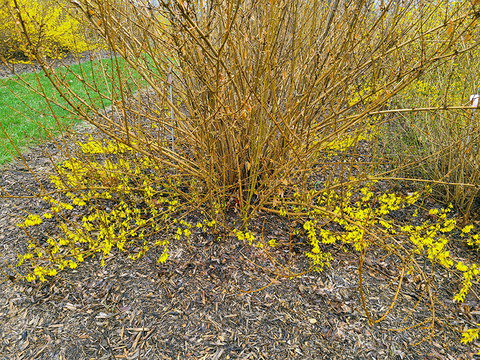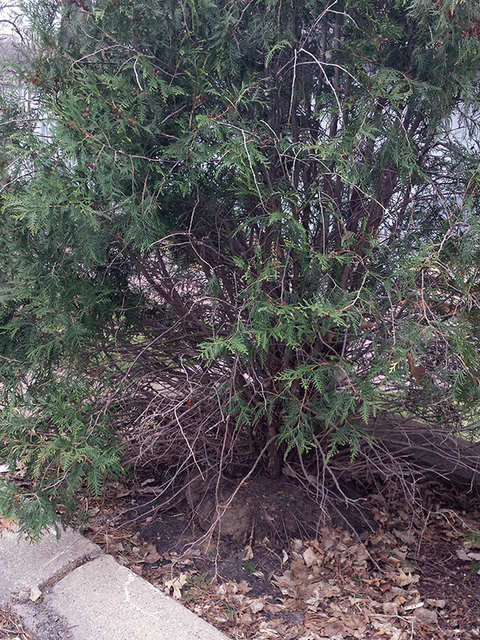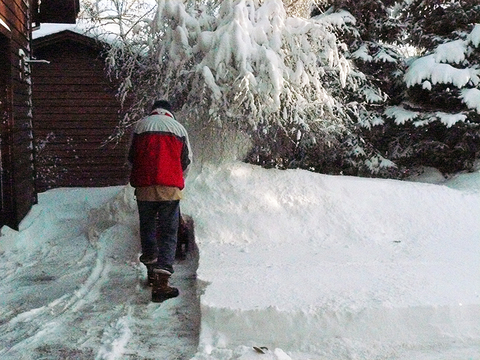Winterizing plants: Cold damage
UNIVERSITY OF MINNESOTA EXTENSION - www.extension.umn.edu
This forsythia may have hardy plant stems and leaf buds, but its flower buds were killed by cold temperatures. The flowers at the bottom of the plant were protected by snow cover.
Minnesota winters can be snowy, frigid, warm, dry or any combination of the above. Weather extremes and variability due to climate change add to the uncertainty and sometimes Minnesota gardening can feel a little like watching a volleyball match.
Cold damage to plants can be caused by:
- Lack of plant hardiness.
- Extreme winter conditions.
- Lack of snow cover and insulation.
- Dry soil and drought conditions.
- Branch breakage from heavy snow and ice.
- Environmental stresses such as de-icing salt.
Plant hardiness
Plants are evaluated by breeders and growers for many things such as flower bloom, disease resistance, size, growing requirements and plant hardiness. Plant hardiness is determined by a plant’s resiliency to varying temperatures.
In Minnesota, plant labels indicate the cold hardiness of a plant by its hardiness zones established by data collected by the U.S. Department of Agriculture. We have the following zones in our state:
- 3a: Hardy to -35 to -40º F
- 3b: Hardy to -30 to -35º F
- 4a: Hardy to -25 to -30º F
- 4b: Hardy to -20 to -25º F
- 5a: Hardy to -15 to -20º F
Winter dieback is a term used when a plant or parts of a plant are killed by cold temperatures. Plant shoots and especially flower buds are most susceptible to winter dieback due to lack of hardiness, early emergence from dormancy or late frosts. It is possible for a tree or shrub to survive cold temperatures but its flower buds do not.
Not much can be done to protect trees and shrubs from dieback during the winter and no plant is 100% resilient, especially when we experience extreme winter cold, ice storms, and lack of snow cover. But gardeners can minimize the potential from winter dieback by selecting plants that are labeled for their cold hardiness zone.
Do not prune, fertilize or overwater plants in late summer or fall as it prompts the plant to put on new growth late in the season. Late-season new growth usually will not become successfully dormant and will be killed by cold temperatures.
If you choose to experiment with marginally hardy plants, locate them in sheltered locations.
Lack of snow cover and soil moisture
Lack of snow cover and dry, droughty conditions negatively influence winter soil temperatures and cause root injury. Snow cover and mulch are good insulators and help keep soil temperatures warmer. Snow is 90-95% air and the air pockets in snow are 32◦F.
Soil moisture is important to root and plant health. Minnesota frost depths range from 42 to 60 inches.
- Sandy or dry soils are colder and have deeper frost levels than moist soil.
- Moist soil holds more heat than dry soil, preventing deeper frost penetration.
Why roots are easily damaged by cold
A poorly planted arborvitae heaves from the soil, exposing its roots to cold temperatures and potential root injury.
Roots are less hardy and become dormant more slowly than a plant’s stems, branches and buds, and will die at temperatures below 10◦F. Roots survive winter because soil temperatures are normally much warmer than air temperatures and soil cools down more slowly than air.
Root damage occurs when cracks in the soil allow cold air to permeate and harm roots, slowing their growth, and when we experience frost heaving. Frost heaving is the repeated freezing and thawing of the soil in fall or spring. This causes soil to expand and contract, pushing shrubs up from the ground and exposing roots to cold.
Heavy snow and ice can bend and break branches. Trees with more than one central leader, narrow crotches and included bark are most susceptible. Upright evergreens and clump trees also hold snow and can be damaged. Proper pruning to eliminate multiple leaders and weak branch attachments starting when the trees are small is important to reducing breakage.
Hiring a professional arborist is always a good investment. They can offer pruning as well as advice on how to protect mature trees with form issues.
De-icing salts (chloride)
When choosing plants near walks and driveways, think about how you remove snow and where you need to store it. Heavy snow can break branches of shrubs and small trees. Choose herbaceous plants instead
Cold weather means ice and snow on roads, driveways and sidewalks. De-icing salts are important when reducing ice occurs and increases the likelihood of people falling and injuring themselves. But they can have negative effects on the environment, especially water quality, and salt spray and run-off can cause and exacerbate winter injury to plants. De-icing salts can build up in soil resulting in root injury, and they can be absorbed by plants, killing stems and foliage.
Fortunately, Minnesota companies and municipalities are using more alternatives to salt for managing ice and snow. Read more about the effects of de-icing salts on landscapes.
Prevent salt damage
- Clear snow from hardscapes as soon as possible to reduce slippery areas.
- Use alternative de-icing salts (calcium chloride and calcium magnesium acetate).
- Follow application instructions.
- Apply the minimum amount needed and only where needed.
- Avoid spreading salt on grass and in ditches where water collects.
- Keep plants healthy throughout the year through best practices in watering, pruning, fertilizing and pest management.
- Avoid planting woody plants where salty runoff collects and close to streets where vehicles can throw salt spray onto plants.
- Create burlap barriers to protect plants from salt spray.
- No species is completely tolerant, but choose more salt-tolerant plant species near walks and roads where salt may be applied.
- Ohio buckeye, Austrian pine, Gingko, Honey locust, white polar, black cherry, white oak, etc.



